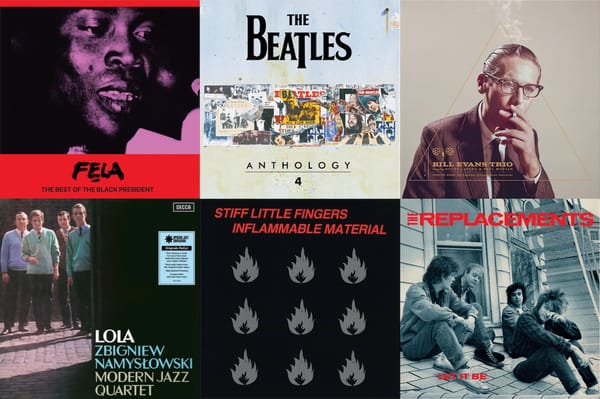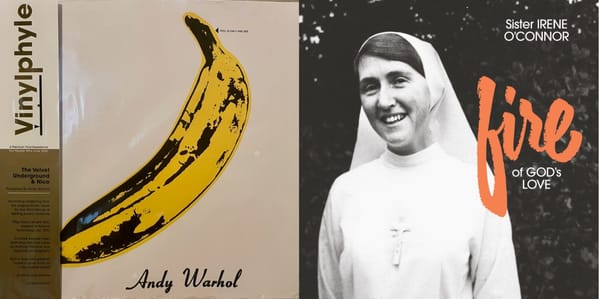Reviews: The Beatles | The Smashing Pumpkins
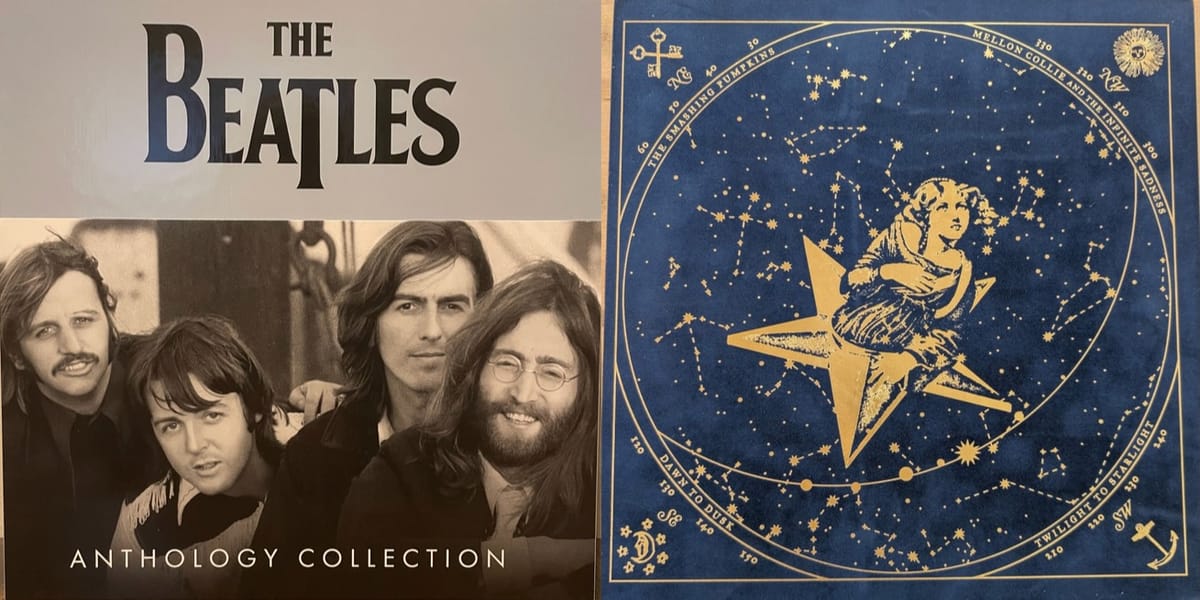
Inside the new Anthology Collection and Mellon Collie and the Infinite Sadness megaboxes.
Christmas came a little early for us at The Vinyl Cut. We got the chance to check out two ridiculously mammoth box sets that drop today, and here our our impressions so that you can judge whether they’re things you’ll want to put on your year-end gift-giving or give-receiving lists.
We carefully listened to every last note of:
The Beatles: Anthology Collection (12 LPs, including the new Anthology 4 set)
If this is your first time checking out The Vinyl Cut, please consider signing up for a subscription so you can get all the vinyl news and reviews in your inbox the second we hit “publish.” And if you’re enjoying what you’ve been reading so far, please tell one vinyl-loving friend about us. We even have a (rattles cup) paid tier if you think what we’re doing is worth supporting financially. It’s cheap! A whole year of supporting our work costs a mere fraction of what a one-step pressing will run you.
We really appreciate all the readers and subscribers so far. It’s been awfully fun putting this thing together, even though we’re writing much more than we initially planned. Thank you to all the readers and subscribers who have come with us on this ride. There’s lots, lots more to come.

The Beatles: Anthology Collection
Review by Ned Lannamann
We have come full circle, friends. With the 30th anniversary of the Beatles’ Anthology—a multimedia project started in 1995 encompassing a TV documentary series, a book, and, of course, a bunch of records—we are now getting the super-deluxe edition of what was essentially a super-deluxe edition to start with. Chalk it up as one more thing the Beatles pioneered before anybody else: issuing outtakes of their outtakes and making them seem like an indispensable part of the canon.
Of course, this is the Beatles we’re talking about, and their cast-offs offer more than historic value—most of their cutting-room detritus is downright enchanting. I spent many hours in recent days listening to all three original volumes of Anthology in succession, and while I’m as familiar with the Beatles’ catalog as I am with any band on Earth’s, I was once again floored by how much they got accomplished in such a short period of time. John, Paul, George, and Ringo’s rate of growth was astronomical, from 1962’s primitive, sing-songy “Love Me Do” to 1964’s near-modal “Every Little Thing” to 1966’s boundary-exploding “Tomorrow Never Knows,” and so on and so on. Anthology is an alternate path through their history—the scenic route, if you will—and traveling it again reminded me how brilliant they were, how everything had to coincide just so for them to make the impact they did, and why their massive success meant that ultimately, it all had to end. If there’s a logline through the Beatles’ story, it’s—to quote Robert Frost—“nothing gold can stay.”
But what gold it was, and the leftovers of that gold are still worth close examination. The massive new 12-LP Anthology Collection includes the first three volumes with the addition of the new Anthology 4, a 3-LP set of stuff from throughout their recorded career, some of it unheard and some familiar. Briefly available only as part of the Anthology Collection box set, Anthology 4 has since been made available separately to those who already own the earlier ones. But the truly devoted-slash-insane Beatle freaks should know that there have been updates to some of the previously released material. A few of the oldest Beatle recordings—before they signed with EMI in 1962—have been sonically upgraded thanks to new technology; I believe some of the live tracks have been improved as well. There may be other changes elsewhere, but what exactly is different is not totally clear to me, apologies.
So what is altogether new here? From what I can tell, 13 of the versions on Anthology 4 are completely unreleased, and a further three are very rare: “This Boy” turned up on the CD single of “Free as a Bird” back in 1995, and “I Saw Her Standing There” and “Money” were made very briefly available on iTunes in 2013 to circumvent a copyright expiration. The newly released tracks date primarily from 1962 to 1965, although they’re accompanied by a batch of Magical Mystery Tour outtakes from 1967 and a run-through of 1968’s “Hey Bulldog” for good measure. All the other Anthology 4 tracks come from the recent deluxe editions of individual albums: 1966’s Revolver, 1967’s Sgt. Pepper’s Lonely Hearts Club Band, 1968’s The Beatles (the White Album), 1969’s Abbey Road, and 1970’s Let It Be. Out of those tracks, some but not all have been released on vinyl before; someone with greater Beatle knowledge and more spare time than me can hammer out exactly which ones those are, but I think they’re generally the ones from Pepper and the White Album. The promotional blurb says that 26 tracks in total have never been on vinyl until now, but depending on how I count, I come up with either 25 or 27, so I’m missing something.
Actually, that’s not all that’s on Anthology 4. Side 6 is taken up with the three John Lennon songs the Beatles worked on after his death as part of the original Anthology project: new mixes of “Free as a Bird” and “Real Love,” whose original mixes appear on Anthology 1 and Anthology 2, respectively, and “Now and Then,” which the Threetles abandoned in the ’90s but which Paul McCartney and Ringo Starr revisited after George Harrison’s death for release in 2023. (Side 6 is pretty short, running about 12 minutes or so.) The older mixes of “Free as a Bird” and “Real Love” are still present on the earlier discs, but these new Side 6 versions used Peter Jackson’s “demixing” technology to improve the sound of Lennon’s vocal and piano; “Now and Then” is the same, as it was able to take advantage of demixing for its original release.
While they’re ostensibly some of the selling points of this new set, I’ll set these posthumous songs aside, simply because they’re unimportant to me. I liked “Free as a Bird” and “Real Love” fine when they came out in the ’90s, and the original versions still sound good to me now, but they simply don’t register in comparison to the group’s earlier work. “Now and Then,” though, always struck me as subpar—a thin, maudlin song that was stretched too thin by overproduction—and the new Anthology 4 mixes of “Free as a Bird” and “Real Love” are a step backwards, too, as Lennon’s voice, while clearer, sounds flat and artificial. The low fidelity of his demo recordings is gone, but so is the shade and mystery of his performance, replaced by a digital simulacrum of his vocal timbre.
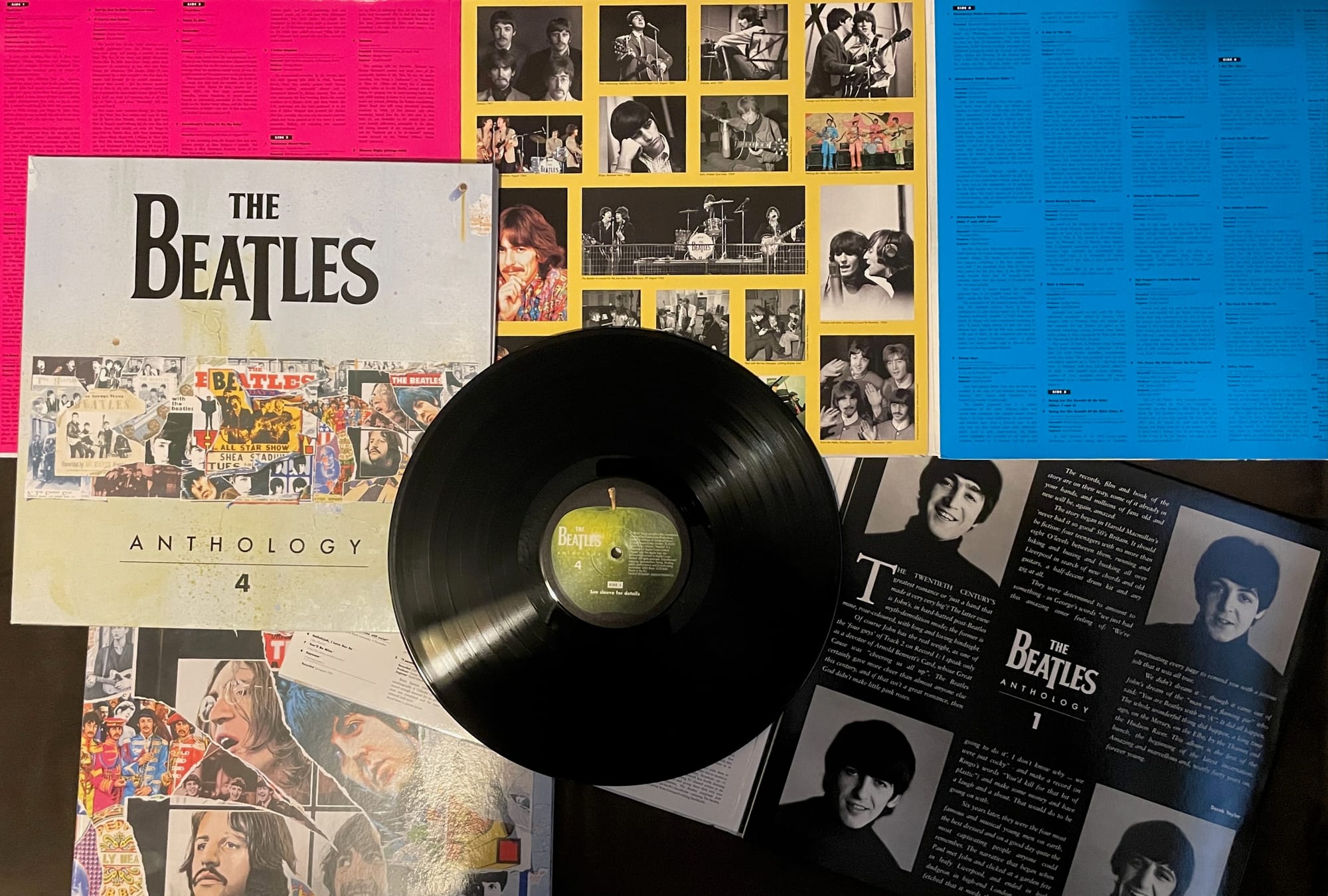
I’m glad these technological experiments are quarantined to the final side of a 12-disc box set, where I can leave them alone, because the rest of this thing is pretty damn glorious. Anthology 1, 2, and 3 are even better listening experiences than I remembered, with Anthology 1 starting off with an audio-documentary approach that includes interview clips, studio chatter, unused takes, live performances, and other odds and ends to give a really rich, detailed portrayal of their career arc. There’s the exuberance of those early years, then Anthology 2 covers the introspection of 1965’s Rubber Soul and the audacious experimenting of Revolver and Sgt. Pepper. And then there’s the Anthology 3 comedown—the sheer garrulousness of the White Album, the worn-out, manufactured spontaneity of Get Back/Let It Be, and the deliberately crafted swan song of the triumphant Abbey Road. Experiencing the side jaunts of these major achievements in roughly 20-minute installments (about the duration of an album side) is kind of ideal, allowing me to absorb the details of exactly how this music was created. Best of all, the new vinyl box sounds miles better than my ’90s CDs, with more air, space, and wholeness to the sound.
So the vinyl’s to be commended. But figuring out who did the mastering and lacquer cut is a bit of a challenge. While the promotional materials credit Giles Martin with the mastering—his work was all likely done in the digital realm—the physical copies of the first three volumes don’t have a mastering credit to be found. Only the fourth volume does: a mastering credit on the back cover for Alex Wharton, an in-house engineer at Abbey Road. In their writeup, Analog Planet states, with corroborating evidence, that Wharton also cut the vinyl lacquers. But I don’t see any identifying information in the deadwax, just the matrix numbers from the pressing plant—except on the very last side of the very last Anthology set. There it is: On Side 6 of Anthology 4, the side with “Free as a Bird,” “Real Love” and “Now and Then,” Wharton’s mark can indeed be seen. Just not on any of the other sides. Analog Planet has a solid source for their info, but I wonder how, without any other identifying marks, the pressing plant knew which lacquers were which before they put their own in-house mark on them. [UPDATE: I have independently confirmed with my press contact that Wharton did indeed cut all the Anthology Collection lacquers.]
In the end, it doesn’t matter. Whether Wharton was involved on the other 23 sides or not, the music sounds uniformly marvelous, down to every last note. The side of previously unreleased Magical Mystery Tour outtakes in Anthology 4 is a particular delight, with instruments rendered in full splendor. “Baby, You’re a Rich Man” thumps along delightfully, and the stripped-down instrumental of “The Fool on the Hill” is full of sparkling detail, like the little recorder whoops that swoop around like birds and a rich, resonant piano holding down the fort before a second piano fills in the spaces on top. Lennon’s vocal in this take of “All You Need Is Love” is just wonderful (as are virtually all of his vocal performances here, in my opinion). And my god, the orchestral mix of “I Am the Walrus” is tremendous enough in itself to warrant a purchase of the entire box. The bass clarinet is given particular room to shine, and the lowing cellos and gliding violins are an outer-space journey in and of themselves—you can easily hear how Electric Light Orchestra derived their entire modus operandi from this one song.
The vinyl, pressed at Optimal, is very good—flat and silent and well pressed. I encountered some whooshing background noise on one of the discs in Anthology 3, but the other 11 discs were as fine as can be. I also noticed some minor sibilance in isolated spots, “Julia” on Anthology 4 being the most flagrant example. The discs come inside white poly-lined sleeves and should be removed carefully, as my discs acquired superficial scuffs from sliding in and out. The box is a heavyweight slipcase with a belly band that you need to slip off to get to the discs, and each 3-LP volume comes in a trifold-style gatefold, printed on thick and excessively glossy cardstock. (Your every fingerprint will be all over this set in a matter of seconds.) Track-by-track annotations are printed inside the trifold jackets, along with a photos from the period and a brief introduction from Derek Taylor. The trifolds are oddly annoying in that two of the interior pockets face each other, making it difficult to get the second and third discs in and out.
But if the package is not utilitarian, what massive box set is? It is handsome in a showpiece kind of way, and I’m only griping because I’m going to want to listen to this thing a lot. The tracklist features revelation after revelation, from the live, raucous sound they got in-studio during their earliest sessions, to the fantastic evolution of masterpieces like “Strawberry Fields Forever,” to all the layered bits and pieces that made up the Abbey Road suite. Of course, there is always the question of what’s been left out this time around, like “Carnival of Light” or the other B-sides from the CD singles of “Free as a Bird” and “Real Love” that have slipped into the mists of time. Their annual Christmas records, too, are still hard to track down. But I’m realizing I’m the kind of fan that could probably listen to everything the Beatles ever recorded, from the aborted takes to the giggly bits of studio banter—which there is plenty of on all four volumes, thank goodness. Maybe someday we’ll get more. Today, we’ve got this, and that’s more than enough for the moment.
Anthology Collection | Apple/Universal 12-LP 180g 33 RPM • mastering by Giles Martin and Alex Wharton at Abbey Road Studios, London • lacquers cut from digital by Alex Wharton • pressed by Optimal, Germany • black vinyl
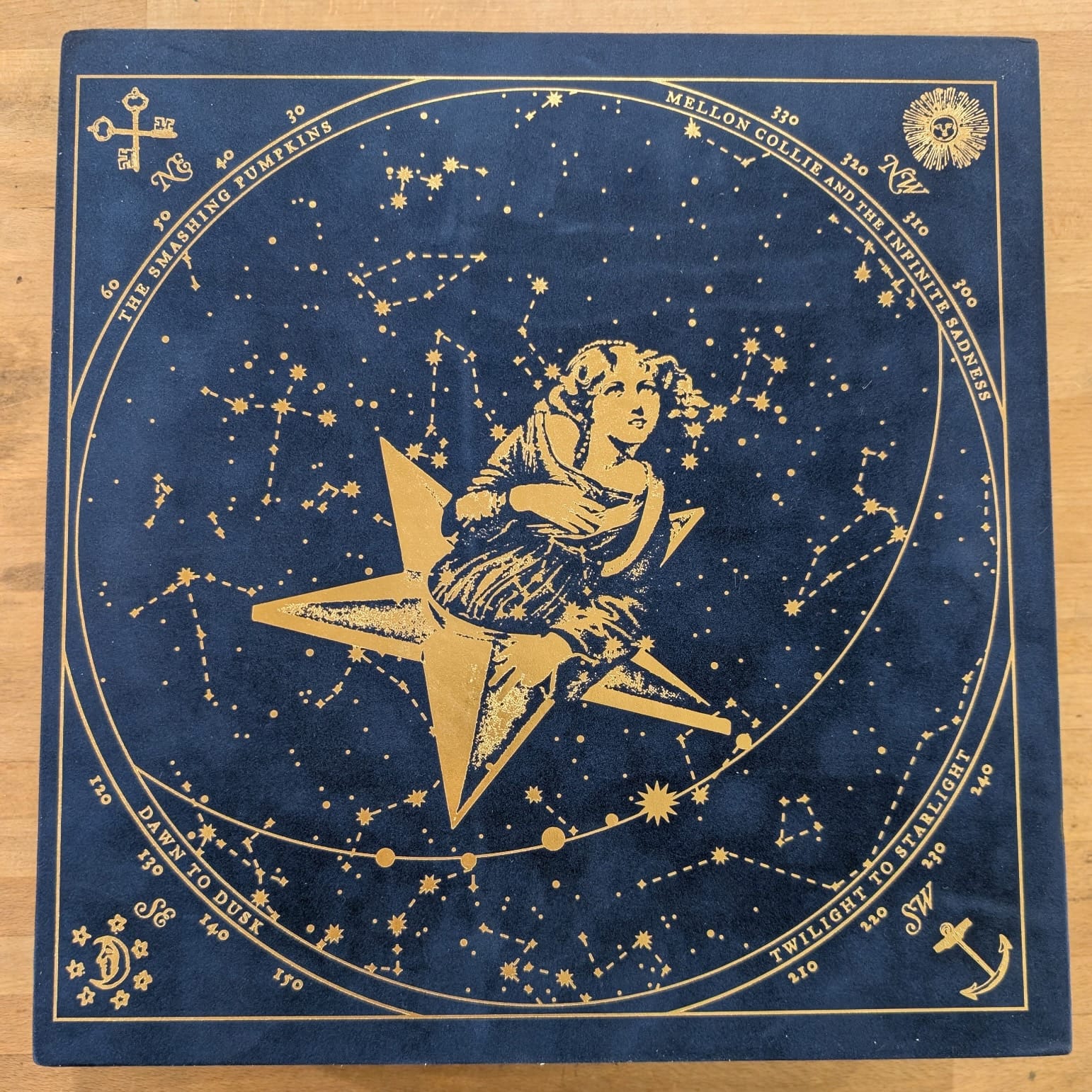
The Smashing Pumpkins: Mellon Collie and the Infinite Sadness 30th anniversary edition
Review by Robert Ham
The 30th anniversary reissue of Mellon Collie and the Infinite Sadness, the third album by Chicago alt-rockers Smashing Pumpkins, is no mere box set of music. This is meant to be a statement piece for one’s record collection.
Each copy comes packed in a large cloth bag, onto which has been printed the image of the woman emerging out of a star that was created by artist John Craig for the original album art. On the other side, the initials “SP” are set inside a heart and written in the now-familiar cursive script of bandleader Billy Corgan. Inside the bag is a box covered in velvet and some lovely astronomical artwork with the stargirl in the center. And inside the box is: a hardbound book featuring lyrics and notes for each of the 28 songs on the album and a new essay from Corgan about the making of the record and the impact it has had on his life for three decades now; a small sheaf of lithographs featuring still images from the videos the group made to promote the album; and a deck of tarot cards inspired by the music. Oh, and there’s six LPs, too: four for Mellon Collie proper and two filled with live material recorded during the long tour the band undertook in 1996—the last time the original lineup of Corgan, guitarist James Iha, bassist D’arcy Wretzky, and drummer Jimmy Chamberlin would share stage time.
Like most things concerning the Smashing Pumpkins these days, the box set is a simultaneously ridiculous and glorious thing. Even the PR email we received for the announcement of this weighty beast admits it’s “for the diehard fans,” of which the Pumpkins have many. And, of course, the timing of its release coincides nicely with next week’s Black Friday and other holiday sales. For Pumpkinheads and ’90s nostalgists, this is going to be the big present under the Christmas tree or the final gift on the last night of Hanukkah.
But is it worth it? Culturally speaking, there’s no question that Mellon Collie deserves some kind of attention to celebrate its pearl anniversary. When the band began to work on the album with British producers Flood and Alan Moulder in the spring of 1995, they had a lot of wind in their sails. Their second album, 1993’s Siamese Dream, was part of the soundtrack for the growing Alternative Nation, debuting at number 10 on the Billboard Hot 200 and ultimately selling over four million copies in the US alone. The group helped their cause by serving as headliners for the 1994 edition of Lollapalooza, even after an already grueling run of shows the year before. That Corgan & Co. had any gas left in the creative tank is fairly remarkable. With cultural capital to spare and a blank check from Virgin Records, Corgan opted to move beyond working with regular collaborator Butch Vig, hired the dudes responsible for the sound of some of his favorite post-punk records, and set about making what the bandleader once described as “The Wall for Generation X.”
Take a few moments to recover from rolling your eyes at that last quote; you need to save your strength to get through the essay Corgan wrote about the creation of this magnum opus. In his telling, he had to dig his heels in with Virgin Records to allow them to make the double album of his dreams. And it was he who was responsible for nearly every note of music within, save the drum parts. At one point Flood, apparently, suggested that the other Pumpkins do some of the heavy lifting, but, as Corgan writes, “None did in any real way, to where their results therein were mixed at best and caused me on many an occasion to have to fix that which I’d had little say on to start.” Only the folks involved know how much of that is true, but their thoughts and memories aren’t part of this official record. Despite Corgan’s insistence that “There was a band, and is a band… and that band is called The Smashing Pumpkins,” this leaves little doubt as to who was and is in charge here.
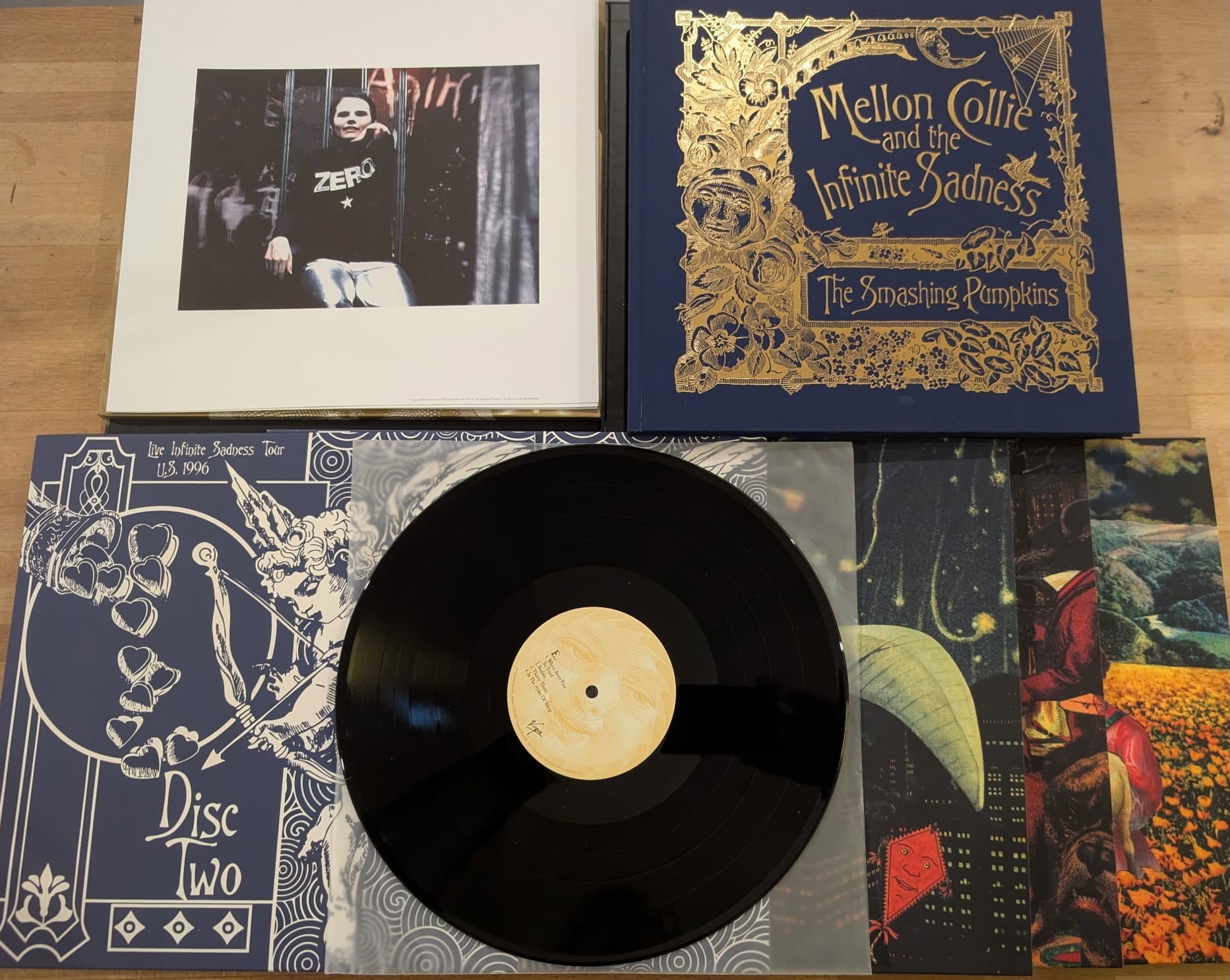
As strong as the results remain when it comes to the finished Mellon Collie, the two discs of live material are all the proof one needs of how capable his chosen bandmates truly were. Though cherry-picked from a variety of shows from their long year on the road in 1996, the band sounds incredible throughout—fierce, airtight, and loud enough to snap the neck of anyone within earshot. Chamberlin is a special highlight throughout, with blazing fills and attention to detail that holds strong even while tempos are ratcheting up. God bless Anika Nilles, the woman that is now part of Rush, but if these recordings are any indication, Chamberlin would have been an equally capable fill-in for the late Neil Peart.
Truth be told, the live recordings are even better sounding than the studio material in this pressing. Our assumption is that this reissue was made using pre-existing masters. According to the credits listed inside the hardcover book included in the set, Bob Ludwig was responsible for mastering the album proper. But as the celebrated engineer retired from the audio game in 2023, I’m doubting he actually took part in this release and Corgan instead went back to the audio that Ludwig mastered for the 2012 CD reissue of Mellon Collie. As for the bonus discs, the credits list Howie Weinberg—who mastered the 1995 CD—as having mastered those, just as he did for the disc of live material that was added to the 2013 re-release of The Aeroplane Flies High, a collection of the singles released from Mellon Collie. While there’s only one song shared between the two box sets—the “Porcelina of the Vast Oceans/Beautiful/Rocket” medley from the July 3, 1996 tour stop in Cleveland—it’s likely Weinberg had a hand in the digital files for all these live recordings that got sifted through for this set.
When mixing the original album sessions, Corgan, Flood, and Moulder emphasized the highs and mids, and Weinberg’s 1995 CD master followed suit, pushing the scream of the guitars and the screech of Corgan’s voice right to the front of the soundstage. Ludwig, however, lets the bass guitar and the low thud of Chamberlin’s kickdrum come to the fore on tracks like “Thirty-Three,” “Bullet with Butterfly Wings,” and “Tonight, Tonight.” It’s not completely off-balance, but still comes out as fairly skewed in one direction. The live tracks, on the other hand, are equalized well and dynamic and almost defiant in tone. Millions of copies sold and Corgan still comes across on these recordings like he has something to prove.
What I can’t say with any confidence is how this compares with other official vinyl pressings of Mellon Collie. There’s the original 1996 edition released in the UK, which squeezed 30 tracks (the 28 from the original album and two bonus tracks) onto three LPs, and a 2012 reissue that restores the proper running order and stretches the material over four LPs. (The latter has been reissued multiple times since.) Without access to those, all I can do is assure potential buyers that my copy of the set, pressed at GZ Media, is fine, flat, and flaw-free, doing proper justice to this big statement by a band at its creative peak.
That said, I have to repeat a question I asked earlier in this review: Is this worth it? For a good number of fans, they’ve likely already answered that by pre-ordering a copy. For those of you who are a little more skeptical and waiting to determine whether an outlay of over $300 makes sense, I think you’ll be making a wise investment. For all of Corgan’s egotistical blather, there’s no denying the man’s talent—a preternatural ability to write catchy, emotionally powerful rock songs that continue to connect with his fellow misfits and misanthropes around the world. With this reissue, his ambition and vision are just as it should be: surrounded by the perfect mix of care and pomposity.
Mellon Collie and the Infinite Sadness | Capitol/Virgin 6-LP 33 RPM • lacquer cut anonymously from unknown source at GZ Media, Czech Republic • pressed at GZ Media • black vinyl

